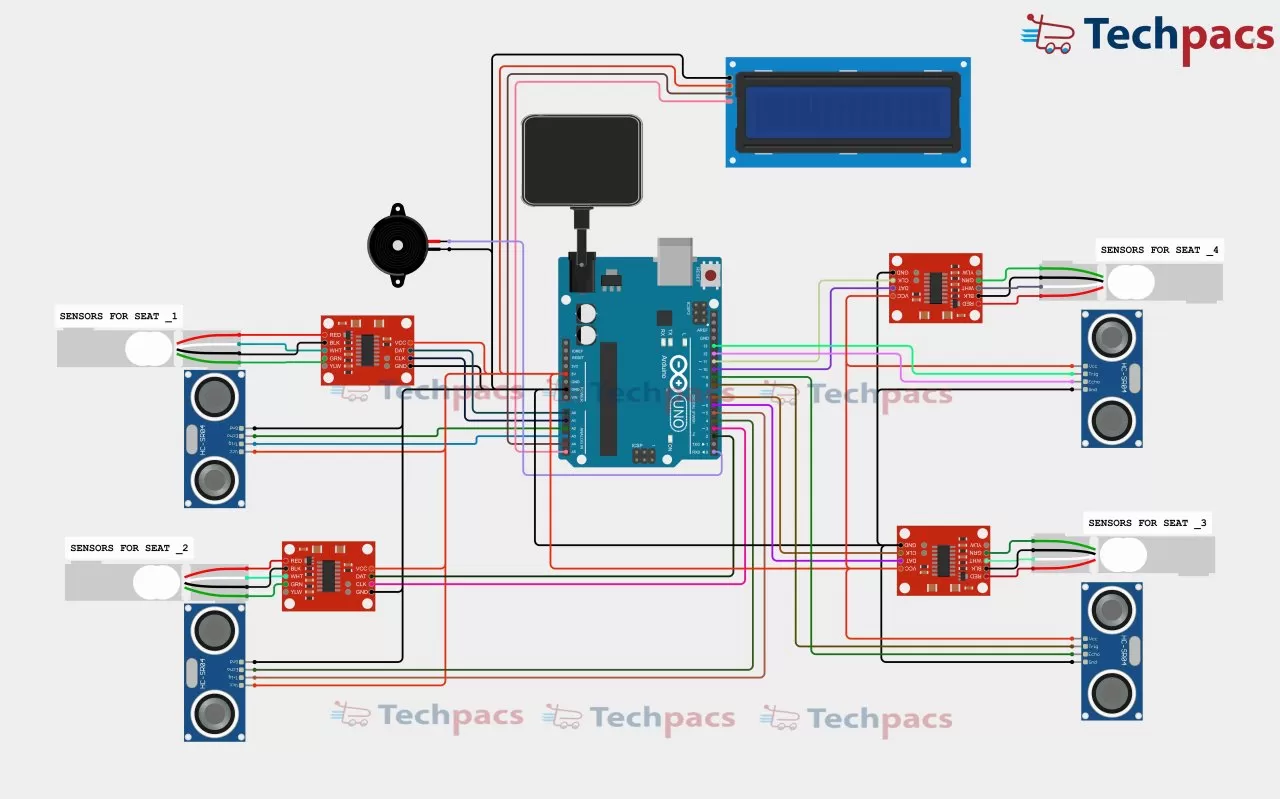Library Seat Management System
Description:
The "Library Seat Management System" is an innovative project aimed at optimizing the use of seating in libraries. The system uses a combination of load cells (HX711) and ultrasonic sensors to monitor and manage the occupancy status of library seats. Each seat is equipped with both a load cell and an ultrasonic sensor to provide accurate and real-time information about seat usage. A seat is considered "booked" only when two conditions are met simultaneously: the weight detected by the load cell exceeds a predefined threshold, and the ultrasonic sensor registers a distance below a certain threshold, indicating the presence of a person. If either condition is not met, the seat is marked as "vacant." The system's status is displayed on a 20x4 LCD, providing clear and immediate feedback on seat availability, helping library staff and visitors to quickly find vacant seats, and ensuring efficient seat utilization.
Objectives:
- Enhance Seat Utilization: To ensure optimal use of library seating by accurately detecting and displaying seat occupancy in real time.
- Improve User Experience: Provide library users with clear information on seat availability, reducing time spent searching for available seats.
- Facilitate Efficient Library Management: Assist library staff in monitoring seating arrangements, reducing manual effort, and improving the overall management of library resources.
- Promote Order and Convenience: Maintain a quiet and organized environment by minimizing disruptions caused by users searching for seats.
- Real-Time Monitoring: Ensure up-to-date status monitoring of seats to handle peak times efficiently.
Key Features:
- Dual-Sensor Detection: Combines load cell data and ultrasonic sensor readings to accurately detect seat occupancy.
- Real-Time Status Display: Shows seat status on a 20x4 LCD, allowing users and staff to see current occupancy at a glance.
- Threshold-Based Booking: Uses predefined thresholds for load cells and ultrasonic sensors to ensure reliable detection of seat occupancy.
- Automated Monitoring: Continuously monitors seat status without the need for manual intervention, improving operational efficiency.
- User-Friendly Interface: Provides an easy-to-read display for both library staff and visitors to quickly check seat availability.
- Low Power Consumption: Efficiently designed to operate with minimal power, making it cost-effective for long-term use.
Application Areas:
- Libraries and Study Rooms: Monitor and manage seating to ensure efficient use of resources and enhance the user experience.
- Educational Institutions: Use in classrooms, study halls, or lecture rooms to track attendance and seat utilization.
- Co-Working Spaces: Helps manage and display seat availability in shared work environments.
- Public Waiting Areas: Can be adapted for use in airports, bus stations, and hospitals to indicate available seating.
Detailed Working of the Library Seat Management System:
- Initialization: The system is initialized by powering on the microcontroller, which activates all connected components, including load cells, ultrasonic sensors, and the LCD display.
- Seat Monitoring: Each seat is equipped with one HX711 load cell and one ultrasonic sensor. The load cell measures the weight on the seat, while the ultrasonic sensor measures the distance to the nearest object (typically the user).
- Data Processing: The system continuously reads data from both sensors. If the load cell value exceeds a predefined threshold and the ultrasonic sensor detects a distance shorter than its set threshold, the system determines that the seat is occupied.
- Seat Status Update: When both conditions are met, the system marks the seat as "booked." If either condition is not met, the seat is marked as "vacant."
- Display Output: The 20x4 LCD display shows the real-time status of each seat, updating dynamically as the occupancy changes.
- Continuous Monitoring: The system operates continuously, ensuring that any changes in seat occupancy are immediately detected and displayed.

Modules Used to Make the Library Seat Management System:
- Sensor Module: Includes the HX711 load cells and ultrasonic sensors to detect seat occupancy based on weight and distance.
- Data Processing Module: A microcontroller (such as an Arduino or Raspberry Pi) processes the sensor data and determines seat status.
- Display Module: The 20x4 LCD display shows the real-time status of each seat.
- Power Management Module: Manages the power supply to all components, ensuring efficient energy consumption.
- Threshold Control Module: Sets and manages the thresholds for both the load cells and ultrasonic sensors to accurately detect seat occupancy.
Components Used in the Library Seat Management System:
- HX711 Load Cells (x4): Detect the weight on each seat to determine if it is occupied.
- Ultrasonic Sensors (x4): Measure the distance to the nearest object (the user) to confirm seat occupancy.
- Microcontroller (e.g., Arduino or Raspberry Pi): Central unit for processing data from sensors and controlling the display.
- LCD Display (20x4): Provides a visual representation of seat status for library users and staff.
- Connecting Wires and Breadboards: For circuit connections and sensor interfacing.
- Power Supply: Supplies necessary power to the microcontroller, sensors, and LCD display.
Other Possible Projects Using this Project Kit:
- Classroom Attendance System: Adapt the system to track student attendance based on seat occupancy in classrooms.
- Smart Office Desk Management: Use the sensors to monitor desk usage in co-working spaces or offices, optimizing space allocation.
- Public Transport Seat Monitoring: Implement the system in buses or trains to indicate available seating.
- Smart Theater Seat Booking: Use the system in theaters or auditoriums to automatically update seat occupancy and booking status.
| Shipping Cost |
|
No reviews found!




























































No comments found for this product. Be the first to comment!